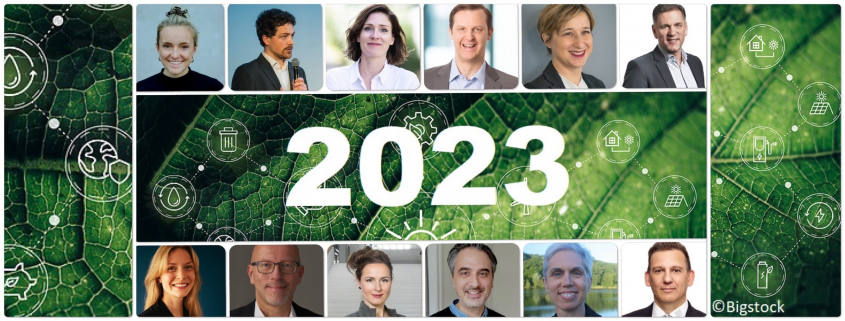The many ways in which technology can contribute to sustainability were very much a part of our 2022 communications and PR initiatives. Therefore, we asked our clients as well as industry experts and contributors to our CleanEnergy-Project “Which developments will contribute to more sustainability in 2023?”. As their answers show, the starting points for more sustainability are multi-faceted. Accelerating the energy transition is not only a priority in the context of the climate goals.
The topic will also be a priority with regard to independence from energy imports and economic stability. Due to the obligation to report on ESG (environmental, social, governance), companies must also disclose their sustainability strategies. Analysts assume that by 2024, 80 percent of G2000 companies will already be collecting their CO2 data. ESG performance will thus become a standard component of risk assessment in relation to companies in the future. Our compilation of expert assessments provides concrete examples of starting points and trends from different technology and business perspectives.
Expansion of storage capacity
The expansion of storage capacity is undoubtedly one of the most important levers for accelerating the energy transition and using energy resources more sustainably. The topic of energy self-consumption with the combination of PV and battery storage is becoming increasingly popular with consumers. But there is also enormous potential for commercial applications – from the use of battery storage for load management, consumption or price peak shaving or for energy backup and emergency power supply. Therefore, we can expect many exciting new applications in 2023.
Florian Blaser, EFT-Systems, official partner for BYD Battery-Box Europe
CO2 accounting sustainability initiatives in companies
The importance of digitization for the sustainability of companies will continue to grow in 2023. Example carbon footprint: IT provides the data that organizations need to meet legal requirements and achieve their sustainability goals along the entire supply-chain. From our own fleet of vehicles to heating and air conditioning to waste disposal. Natural Language Processing (NLP), for example, analyzes invoices for purchased goods and services in order to calculate the carbon footprint more precisely. In this way, effective measures for decarbonization can be identified and promoted.
Dr Larissa Talmon-Gros, Co-Lead Center of Excellence Sustainability at NTT DATA DACH
Technology supporting energy optimization in companies
When hear “climate killers” we think of combustion engines, smoking chimneys, and deforestation. But did you know that around 4% of global carbon emissions are attributed to the IT industry? That’s as much as the aviation industry causes. Therefore, the pressure on companies to rethink their IT structures is increasing. In view of rising energy prices, energy consumption is not only a high cost factor. There are many ways to tackle carbon emission reduction in the digital space, from moving to the cloud, using Platform-as-a-Service to coding more efficiently. It’s an exciting time for people working on these topics.
Leah Goldfarb, Environmental Impact Officer, Platform.sh
Resource-efficient planning
Daniel Priem, Senior Expert Mobility & Sustainable Cities at Ubilabs
Green hydrogen as important building block for decarbonization
Robin v Plettenberg, CEO at H-TEC SYSTEMS
Future technologies help to make the textile industry more sustainable
Verena Ziegler, CEO OpenDress GmbH – BEAWEAR
Returns management: the more sustainable, the more profitable
Barbara Brunelli, Business Development Manager at BuyBay
Building with fewer resources
Andreas Borgstaedt, Business Development Precast Concrete, Holcim Deutschland GmbH
More sustainable packaging alternatives
Juni Sun Neyenhuys, Co-Founder, Mujō
Sustainable purchase options at no extra cost
Eva Aumüller, Founder & MD, toern
Transparency and common standards for the circular economy
Jörg Walden, founder of CircularTree
High potential for municipalities and citizens
Patrik Danz, CSO at IBC SOLAR
Sustainability has many Faces
Of course this compilation cannot cover all trends and developments in the field of sustainability. However, the interesting insights that the experts have provided us with show what contribution innovative approaches and technology can make in the most diverse fields of application. It is no great surprise that the expansion of renewable energies and their efficient use for even more fields of application play an important role. But innovative technologies and intelligent concepts can also make a decisive contribution in many other areas. The concepts and solutions, presented by industry experts, inventors and entrepreneurs help companies to become more energy-efficient or find ways to make entire sectors and particularly resource-consuming processes more environmentally friendly. 2022 was an exciting year for PR professionals working in the field of technology and sustainability and we are looking to more exciting topics in 2023.
Sources and Copyright: The copyright for the portrait lies with the person portrayed.













